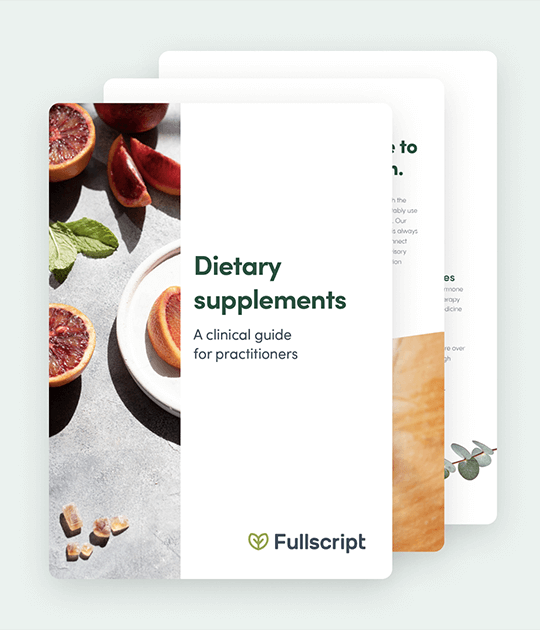The World Health Organization reported that the number of individuals worldwide over 60 years old is expected to double by 2050. (29) With this increase in our aging population, understanding the factors that impact health and disease as we age becomes necessary to maintain longevity and quality of life.
From Alzheimer’s and Parkinson’s disease to osteoarthritis and atherosclerosis, the risk of several chronic health conditions increases with age. (16) While aging is a normal process, many chronic diseases associated with aging can be prevented and even reversed. (3)(5)(28) Certain lifestyle and dietary modifications can help to support human longevity and health throughout the lifespan. (28) This article outlines the concept of aging and longevity, as well as the top nutrients to include in your diet to promote extended life expectancy.
What is longevity and aging?
Also referred to as senescence, aging is the progressive and normal deterioration of anatomic structures and physiological processes in the body. (3) While longevity is simply defined as “a long duration of individual life”, (13) healthy aging and longevity involve not only extending an individual’s lifespan but also improving health and quality of life while aging.
Scientists are still working to fully understand the causes of aging, however, numerous mechanisms of aging have been proposed. Several cellular and molecular markers are believed to be involved in the aging process. Markers of aging include:
- Altered intercellular communication
- Cellular senescence
- Deregulated nutrient-sensing
- Epigenetic alterations
- Genomic instability
- Loss of proteostasis
- Mitochondrial dysfunction
- Stem cell exhaustion
- Telomere attrition (14)
An individual’s progression of aging can be understood by their phenotype, a combination of their genotype (genetic makeup) and external factors, such as diet, lifestyle, and environment. (3) A number of processes and pathologies contributing to biological aging have been identified, including cellular damage, inflammation, and atherosclerosis. (14) Cellular damage results from oxidative stress, which occurs when there are insufficient antioxidants available to counteract the harmful effects of reactive oxygen species (ROSs). Oxidative stress may play a role in many chronic diseases, including diabetes, cancer, chronic kidney disease, and neurodegenerative and cardiovascular diseases. (7) Targeting these biological processes may help prevent disease and promote healthy aging and longevity.

Including specific nutrients in the diet can help promote longevity and healthy aging.
The role of diet and lifestyle in aging and longevity
Many lifestyle factors, such as engaging in regular physical activity, moderating intake of alcohol, and consuming a healthy diet, may reduce morbidity and mortality risk. (20) One study of aging adults suggests that social engagement, sleep, and physical activity can impact cognitive function and overall brain health. It was found that increased conversation time and the number of walking steps provided protection against cognitive decline. It was also reported that total sleep time between 4.86 and 8.25 hours per night prevented cognitive impairment, while sleep time over 7.24 hours per night may negatively impact cognitive function. (9) A healthy diet can improve some aging-related changes by reducing inflammation and positively impacting metabolic health. Foods that have been associated with reduced systemic inflammation include fish high in omega-3 fatty acids, healthy fats, and fiber-rich foods, such as whole grains, vegetables, and fruit. (20) Outlined below are some of the top nutrients for longevity and the food sources in which they are found.Top nutrients for longevity
Research has shown that certain nutrients found in whole foods support overall health and promote longer life expectancy. Examples of whole foods include fish, legumes, whole grains, berries, and veggies, particularly leafy greens. Keep reading to learn about the top ingredients and their benefits.Coenzyme Q10
Coenzyme Q10 (CoQ10) is a fat-soluble compound found in the heart, kidneys, liver, and pancreas of humans. Levels of CoQ10 are depleted by age-related oxidative stress, mitochondrial diseases, and statin use. Statins are lipid-lowering medications commonly prescribed for primary prevention of atherosclerotic cardiovascular disease (ASCVD) in aging adults. (8) CoQ10 supplementation may support cardiovascular health by lowering levels of the inflammatory marker interleukin-6 and protecting against oxidative stress. (2) Furthermore, CoQ10 supplementation may improve blood sugar regulation and has been shown to reduce glycosylated hemoglobin (HbA1C), which measures the average level of blood sugar over the last few months. (8) Deficiency in CoQ10 has been associated with type 2 diabetes, fibromyalgia, cancer, neurodegenerative, and heart disease. (8) CoQ10 is synthesized in the body and may be obtained from several food sources, including organ meats (e.g., liver, kidney, heart), sardines, herring, peanuts, spinach, and broccoli. (21)Omega-3 fatty acids
Omega-3 fatty acids are a group of long-chain fatty acids that include alpha-linoleic acid (ALA), eicosapentaenoic acid (EPA), and docosahexaenoic acid (DHA). While ALA may be obtained from plant foods, such as walnuts, flax, chia, and hemp seeds, (27) the conversion of ALA to EPA and DHA is limited in humans. (1) EPA and DHA, considered to be the main health-promoting omega-3s, have been shown to increase levels of anti-inflammatory cytokines. (20) High amounts of EPA and DHA fatty acids are found in fatty fish, such as salmon, sardines, herring, mackerel, anchovies, and cod liver oil. (27) A meta-analysis of 21 studies identified a link between regular fish consumption and reduced risk of certain chronic health conditions, such as breast cancer, (30) heart disease, (11) and osteoporosis. (4) Fish oil supplementation appears to exert cardioprotective effects by reducing triglyceride levels, lowering blood pressure, and decreasing platelet aggregation. (11)
EPA and DHA found in fish oil are considered to be potent anti-inflammatories.
Probiotics and prebiotics
Another way to promote healthy aging is by supporting a balanced population of microbes that inhabit the gastrointestinal tract, known as the gut microbiota. Longevity studies in Italian and Chinese centenarians have identified the presence of some common beneficial bacteria in both cohorts, including Ruminococcaceae, Akkermansia, and Christensenellaceae families of bacteria. These bacteria are associated with immunomodulation, regulation of body mass index, and healthy homeostasis. Furthermore, greater diversity in microbiota is commonly considered an indicator of good health. (10) Intestinal microbes feed on prebiotics, a type of carbohydrate found in foods such as leeks, garlic, onions, asparagus, Jerusalem artichokes, chicory, oats, wheat, chickpeas, and soybeans. (24) A diet high in prebiotic fiber is associated with increased short-chain fatty acids produced by gut microbiota. This can protect against behavioral and inflammatory conditions. A Mediterranean diet is high in prebiotic fiber, as it includes plenty of vegetables, fruit, beans, and lentils. (22)B vitamins
Elevated homocysteine levels, a biomarker of aging in the body, are linked to reductions in grey matter in the brain, (6) as well as an increased risk of heart disease, Alzheimer’s disease, (12) bone loss, and bone fractures. (26) The body requires certain nutrients to metabolize homocysteine, including pyridoxine (vitamin B6), folate (vitamin B9), and cobalamin (vitamin B12). Good sources of B vitamins include liver, eggs, tuna, lamb, legumes, brown rice, dark leafy greens, nutritional yeast, milk, and yogurt. (17)(18)(19) The Heart Outcomes Prevention Evaluation (HOPE 2) study found that combined supplementation of vitamins B6, B12, and folate reduced homocysteine and risk of stroke by approximately 25%. (23) Learn more about diet and supplements for heart health on the Fullscript blog.Resveratrol
Resveratrol is a polyphenol primarily found in grape skins, red wine, grape juice, berries (e.g., blueberries, cranberries), and peanuts. Research has found resveratrol to exhibit antioxidant, anti-inflammatory, anti-aging, and anti-cancer effects. Resveratrol supplementation has been shown to reduce biomarkers associated with inflammation, including reactive oxygen species (ROS), tumor necrosis factor alpha (TNFα) and interleukin-6 (IL-6). (25) In-vivo and in-vitro animal studies suggest that resveratrol may exert health benefits by inhibiting a process called glycation, which involves a reaction between proteins and sugars that produces advanced glycation end products (AGEs). AGEs are considered a biomarker of aging, as they can accumulate and cause damage to cells and tissues. (7)
Resveratrol, a polyhpenol compound, is concentrated in grape skins.
The bottom line
While an individual’s experience of aging is partly determined by genetics, lifestyle and dietary factors can play a significant role in healthy aging and the prevention of age-related conditions. Nutrients such as CoQ10, omega-3 fatty acids, prebiotics, B vitamins, and resveratrol can help to promote longevity. Including these nutrients in your diet or obtaining them through supplementation may help to prevent some of the chronic conditions associated with aging. For more information or to determine if these nutrients would be beneficial to your overall health plan, speak to an integrative healthcare provider.- Baker, E. J., Miles, E. A., Burdge, G. C., Yaqoob, P., & Calder, P. C. (2016). Metabolism and functional effects of plant-derived omega-3 fatty acids in humans. Progress in Lipid Research, 64, 30-56.
- Bronzato, S., & Durante, A. (2018). Dietary supplements and cardiovascular diseases. International journal of preventive medicine, 9, 80.
- da Costa, J. P., Vitorino, R., Silva, G. M., Vogel, C., Duarte, A. C., & Rocha-Santos, T. (2016). A synopsis on aging – Theories, mechanisms and future prospects. Ageing research reviews, 29, 90–112.
- Farina, E. K., Kiel, D. P., Roubenoff, R., Schaefer, E. J., Cupples, L. A., & Tucker, K. L. (2011). Protective effects of fish intake and interactive effects of long-chain polyunsaturated fatty acid intakes on hip bone mineral density in older adults: the Framingham Osteoporosis Study. The American journal of clinical nutrition, 93(5), 1142-1151.
- Fontana L. (2009). Modulating human aging and age-associated diseases. Biochimica et biophysica acta, 1790(10), 1133-1138.
- Ford, A. H., Garrido, G. J., Beer, C., Lautenschlager, N. T., Arnolda, L., Flicker, L., & Almeida, O. P. (2012). Homocysteine, grey matter and cognitive function in adults with cardiovascular disease. PLoS ONE, 7(3).
- Galiniak, S., Aebisher, D., & Bartusik-Aebisher, D. (2019). Health benefits of resveratrol administration. Acta Biochimica Polonica, 66(1), 13-21.
- Garrido-Maraver, J., Cordero, M. D., Oropesa-Avila, M., Vega, A. F., de la Mata, M., Pavon, A. D., … Sanchez-Alcazar, J. A. (2014). Clinical applications of coenzyme Q₁₀. Frontiers in Bioscience, 19(4), 619.
- Kimura, N., Aso, Y., Yabuuchi, K., Ishibashi, M., Hori, D., Sasaki, Y., … Matsubara, E. (2019). Modifiable lifestyle factors and cognitive function in older people: A cross sectional observational study. Frontiers in neurology, 10, 401.
- Kong, F., Hua, Y., Zeng, B., Ning, R., Li, Y., & Zhao, J. (2016). Gut microbiota signatures of longevity. Current Biology, 26(18).
- Kris-Etherton, P. M., Harris, W. S., & Appel, L. J. (2002). Fish consumption, fish oil, omega-3 fatty acids, and cardiovascular disease. Circulation, 106(21), 2747-2757.
- Kumar, A., Palfrey, H. A., Pathak, R., Kadowitz, P. J., Gettys, T. W., & Murthy, S. N. (2017). The metabolism and significance of homocysteine in nutrition and health. Nutrition & metabolism, 14, 78.
- Longevity . (n.d.). Merriam-Webster Online. Retrieved from https://www.merriam-webster.com/dictionary/longevity
- López-Otín, C., Blasco, M. A., Partridge, L., Serrano, M., & Kroemer, G. (2013). The hallmarks of aging. Cell, 153(6), 1194–1217.
- McDonald, R. B., & Ruhe, R. C. (2011). Aging and longevity: Why knowing the difference is important to nutrition research. Nutrients, 3(3), 274–282.
- McGeer, P. L., & McGeer, E. G. (2006). Inflammation and the degenerative diseases of aging. Annals of the New York Academy of Sciences, 1035(1), 104-116.
- National Institutes of Health. (2019). Folate: Fact sheet for health professionals. Retrieved from https://ods.od.nih.gov/factsheets/Folate-HealthProfessional/
- National Institutes of Health. (2019). Vitamin B6: Fact sheet for health professionals. Retrieved from https://ods.od.nih.gov/factsheets/VitaminB6-HealthProfessional/
- National Institutes of Health. (2019). Vitamin B12: Fact sheet for health professionals. Retrieved from https://ods.od.nih.gov/factsheets/VitaminB12-HealthProfessional/
- Quach, A., Levine, M. E., Tanaka, T., Lu, A. T., Chen, B. H., Ferrucci, L., … Horvath, S. (2017). Epigenetic clock analysis of diet, exercise, education, and lifestyle factors. Aging, 9(2), 419-446.
- Rodick, T. C., Seibels, D. R., Babu, J. R., Huggins, K. W., Ren, G., & Mathews, S. T. (2017). Potential role of coenzyme Q10 in health and disease conditions. Nutrition and Dietary Supplements, 10, 1-11.
- Santoro, A., Ostan, R., Candela, M., Biagi, E., Brigidi, P., Capri, M., & Franceschi, C. (2018). Gut microbiota changes in the extreme decades of human life: A focus on centenarians. Cellular and molecular life sciences, 75(1), 129-148.
- Saposnik, G., Ray, J. G., Sheridan, P., Mcqueen, M., & Lonn, E. (2009). Homocysteine-lowering therapy and stroke risk, severity, and disability. Stroke, 40(4), 1365-1372.
- Slavin, J. (2013). Fiber and prebiotics: Mechanisms and health benefits. Nutrients, 5(4), 1417-1435.
- Smoliga, J. M., Baur, J. A., & Hausenblas, H. A. (2011). Resveratrol and health – A comprehensive review of human clinical trials. Molecular Nutrition & Food Research, 55(8), 1129-1141.
- Stone, K. L., Lui, L. Y., Christen, W. G., Troen, A. M., Bauer, D. C., Kado, D., … Manson, J. E. (2017). Effect of combination folic acid, vitamin B6, and vitamin B12 supplementation on fracture risk in women: A randomized, controlled trial. Journal of bone and mineral research, 32(12), 2331-2338.
- USDA. (n.d.). USDA food composition databases. Retrieved from https://ndb.nal.usda.gov/ndb/nutrients/index
- World Health Organization. (2014, October 06). Diet, nutrition and the prevention of chronic diseases: Report of the joint WHO/FAO expert consultation. Retrieved from https://www.who.int/dietphysicalactivity/publications/trs916/summary/en/
- World Health Organization. (2015, October 01). WHO: Number of people over 60 years set to double by 2050; major societal changes required. Retrieved from https://www.who.int/news/item/30-09-2015-who-number-of-people-over-60-years-set-to-double-by-2050-major-societal-changes-required
- Zheng, J., Hu, X., Zhao, Y., Yang, J., & Li, D. (2013). Intake of fish and marine n-3 polyunsaturated fatty acids and risk of breast cancer: Meta-analysis of data from 21 independent prospective cohort studies. Bmj, 346, f3706.





